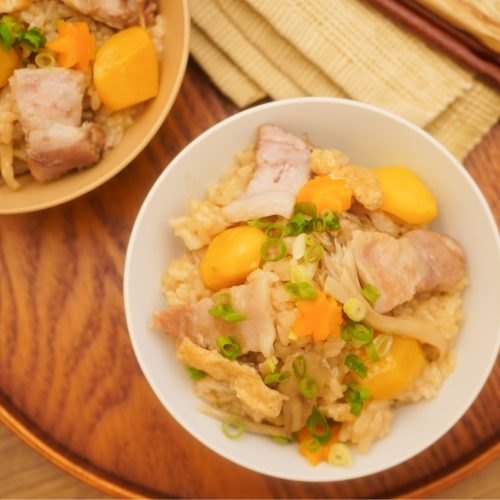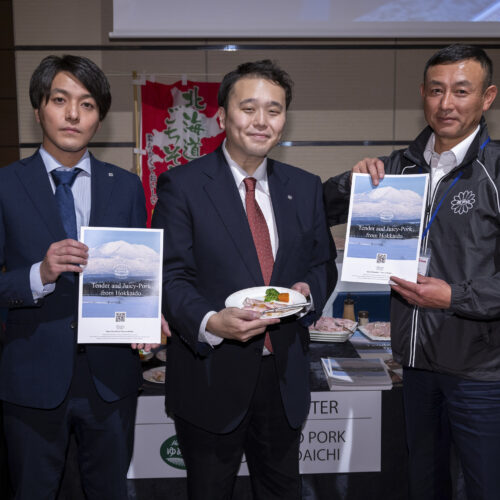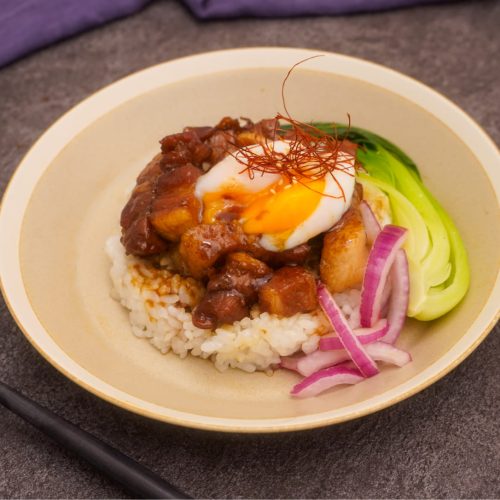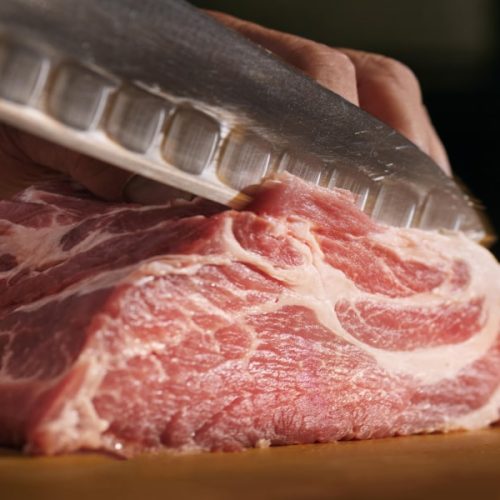Nikujaga
(Pork belly meat and potatoes)
Meat and potatoes are a typical "taste of mom's cooking" in Japan.
"Movie recipe" introduces a classic pork dish familiar to Japanese diners with video clips.
In the second installment of "Movie recipe,"
we introduce a simple yet delicious steamed"Nikujaga".
INGREDIENTS-SERVES 4
- Thinly sliced pork belly 400g
- Onion 1(Approximate weights:250g)
- Carrot 1(Approximate weights:150g)
- Potatos 3(Approximate weights:200g/ potato)
- Shirataki (Thread konjac) 180g
- Sake (Dry white wine) 90cc
- Sugar 2 tablespoons
- Soy sauce 4 tablespoons
- Sesame oil 1 tablespoon
PROCEDURE
- Cut the meat into bite-size pieces (about 10 cm long).
- Cut the onions into wedges, the carrots into chunks, the potatoes into quarters, and remove the strings from the green peas.
- If you have shirataki, boil it in hot water and cut it into bite-size pieces.
- Put sesame oil in a frying pan, add meat and fry while breaking it up.
- When the meat is slightly browned, add the onions, potatoes, carrots, and shirataki noodles, and evenly distribute the ingredients.
- Add sake (or dry white wine if you don’t have it), sugar, and soy sauce, adjust so that the seasoning is evenly distributed, close the lid, and simmer for 20 minutes (mix upside down 2-3 times halfway through).
- Check the firmness of the potatoes and carrots by skewering them (if it goes through easily, it is OK), turn off the heat once, and let cool for about an hour.
- Turn the heat back on, bring to a simmer, add the peas, cook for 2 minutes, and serve.
Point
-
In general, once the simmered dish is finished, it is best to cool it down to allow the flavors to soak in and make it tasty.
In the case of the “Nikujaga,” it is recommended to cool it down before adding the peas.
There are various ways to make “nikujaga” depending on the region and preference.
Basically, pork is often used in the eastern part of Japan, and beef in the western part.
This time, I used pork belly and simmered it with the juices from the meat and the water from the vegetables to make umami rich nikujaga without using soup stock or water.
There is a theory that nikujaga originated from Admiral Togo, who was active in the early 1900s.
He couldn’t forget the taste he ate in England when he studied abroad, and beriberi was prevalent in the navy at the time, so when he asked him to make a highly nutritious beef stew as a shipboard meal, there was no wine or butter.
“Nikujaga” was completed.
It’s such a good story that it’s hard to believe, but that’s what it is. origin is unknown.
The fact that the myth spreads and is believed by many people may be because there are many people who feel close to “nikujaga”.
Pork belly, along with pork loin, is a common ingredient in pork dishes. In Japan, it is called “bara-meat” because the ribs are called “abara.
The meat with the bone attached is also called “spare ribs.
Pork belly is less susceptible to exercise than the parts near the shoulder and buttocks, so it is more tender and juicy, and has a lot of flavor from its marbled fat.
In addition to meatballs, there are other stewed dishes made with chunks of meat, such as “kakuni,” or stewed pork belly, and stir-fried with kimchi, which are loved by many people.
Yongenton*1“Yume no Daichi” pork is blended with the “Berkshire” breed, which is popular for its high quality “sashi” (fatty meat) sandwiched between the lean meat and sweeter fat compared to regular pork and Sangenton*1pork.
*1 Yongenton Pork are born from a combination of two maternal breeds and two paternal breeds.
The maternal line is a crossbreed of the Landrace, which has excellent lean meat, and the Great Yorkshire, which is a good rearing breed. The paternal line is a crossbreed of the Duroc, which produces superb fat meat, and the Berkshire, which has fine so-called “sashi,” or fat with a sweet taste.
Recommend post
-

RECIPE
Rice cooked with chestnuts and pork.Seasonal recipes to enjoy
autumn vegetables and
"Yume no Daichi" -

RECIPE
Goya champloo with deep-fried tofuSeasonal recipes to enjoy
early summer vegetables and
"Yume no Daichi" -

NEWS
We participated in the 2024 JAPANESE WAGYU WORLD AUCTION.
-

RECIPE
Rouloulhan with hot spring egg.Seasonal recipes to enjoy summer vegetables and "Yume no Daichi"
-

COLUMN
About the pork we eat.Porkology vol.1
-

NEWS
Completed construction of a new plant to serve as an overseas export base for “Yume no Daichi” brand pork.
